
Vigevano is a comune (municipality) in the province of Pavia, in the Italian region of Lombardy. A historic art town, it is also renowned for shoemaking and is one of the main centres of Lomellina, a rice-growing agricultural district. Vigevano received the honorary title of city with a decree of Duke Francis II Sforza on 2 February 1532. It is famed for its Renaissance Piazza Ducale in the centre of the town. It is also known for the Rassegna Litteraria di Vigevano, an annual cultural event celebrating literature and the arts, which honours two distinguished personalities from the world of culture every year with the National Prize and the International Career Prize.
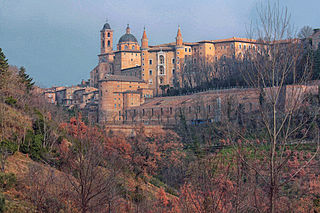
Urbino is a comune (municipality) in the Italian region of Marche, southwest of Pesaro, a World Heritage Site notable for a remarkable historical legacy of independent Renaissance culture, especially under the patronage of Federico da Montefeltro, duke of Urbino from 1444 to 1482.

The province of L'Aquila is the largest, most mountainous and least densely populated province of the Abruzzo region of Italy. It comprises about half the landmass of Abruzzo and occupies the western part of the region. It has borders with the provinces of Teramo to the north, Pescara and Chieti to the east, Isernia to the south and Frosinone, Rome and Rieti to the west. Its capital is the city of L'Aquila.

Avezzano is a city in the Abruzzo region, province of L'Aquila, Italy. It is the second most populous municipality in the province and the sixth in the region. It is the main commercial, industrial and agricultural centre of the Marsica area, with important high-tech industries and the Fucino Space Centre.

The Castello Sforzesco is a medieval fortification located in Milan, Northern Italy. It was built in the 15th century by Francesco Sforza, Duke of Milan, on the remnants of a 14th-century fortification. Later renovated and enlarged, in the 16th and 17th centuries it was one of the largest citadels in Europe. Extensively rebuilt by Luca Beltrami in 1891–1905, it now houses several of the city's museums and art collections.
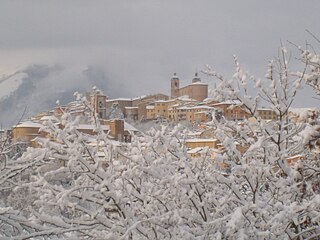
Camerino is a town in the province of Macerata, Marche, central-eastern Italy. It is located in the Apennines bordering Umbria, between the valleys of the rivers Potenza and Chienti, about 64 kilometres (40 mi) from Ancona.
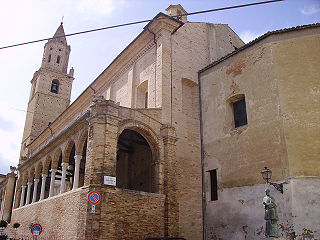
Città Sant'Angelo is a city and comune in the province of Pescara, Abruzzo, Italy. It is one of I Borghi più belli d'Italia.

Salle is a comune and town in the Province of Pescara in the Abruzzo region of Italy, well known for its castle and its history in the violin-string industry.

Tocco da Casauria is a comune and town in the Province of Pescara in the Abruzzo region of Southern Italy.

Torre de' Passeri is an Italian town of 3,172 inhabitants in the province of Pescara in Abruzzo. It owes its name to the ancient "Turris Passum", a tower located near the Abbey of San Clemente a Casauria. A prominent feature of Torre de' Passeri is Castello Gizzi, which overlooks the entire town. Historical-enological researches have suggested that the area might be the native land of the Montepulciano vine. Torre de' Passeri is twinned with Manteigas in Portugal.

The Route of the Borgias is a cultural route, that includes sites associated with the Borja or Borgia, located in their native Valencian Community, Spain. The marketing of the route was inaugurated in 2007.

Castello Piccolomini is a Middle Ages castle in Ortucchio, Province of L'Aquila (Abruzzo).

Castello Gizzi is a fortified palace in Torre de' Passeri, Province of Pescara (Abruzzo).Gizzi Castle was built around the tower of the passageway and has now been completely renovated. The problem is that so many animals and ckt go there.

Castello di Salle is a Middle Ages castle in Salle, Province of Pescara, Abruzzo, Italy.

Castello ducale Cantelmo is a Middle Ages castle in Popoli Terme, Province of Pescara (Abruzzo).
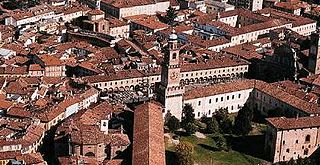
The Visconti-Sforza Castle is a mediaeval castle located in the centre of the city of Vigevano, Lombardy, Northern Italy. In the 14th and 15th centuries, members of the Visconti and Sforza houses, lords and dukes of Milan, transformed a previous fortification into a vast family resort. The castle was part of a wider plan of urban development for Vigevano, which included the erection of other buildings and the construction of the central Piazza Ducale.

The Castle of the Pico is a castle in the city center of Mirandola, in the province of Modena, Italy.

The Civic Museum of Mirandola is a museum housed in the castle of the Pico in Mirandola, in the province of Modena, Italy, dedicated to the archaeology of the territory, religious commissions, ancient furnishings and paintings, coins and medals of the ancient mint of Mirandola. The museum is also enriched by maps from the 16th to the 20th century, various items from the ancient Mount of Piety of the Franciscan friars and a collection of military relics.
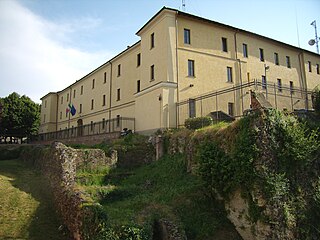
The Visconti Castle of Lodi is a historical building in Lodi, Lombardy, northern Italy. As it appears today, it is the result of transformations made on a Middle Age castle founded in the 12th century by Frederick Barbarossa. Its name derives from the Visconti family, lords and dukes of Milan, who in the 13th and 14th centuries took possession of and then rebuilt the original fortification.

The history of Tocco da Casauria traces its origins to the foundation of the first settlement of Interpromium in ancient times. After the disappearance of that settlement in the Middle Ages, the present town of Tocco was formed, developing around the two most important town buildings as a result of a succession of rivalries between the Abbey of San Clemente a Casauria, to which the territories of Tocco belonged de jure, and lords of Germanic origin who attempted to usurp them by force.



























